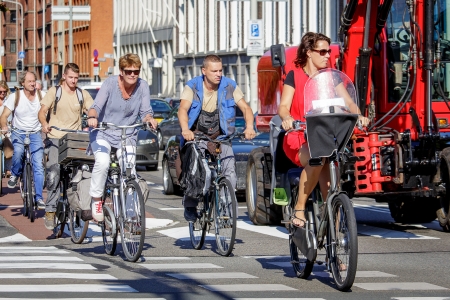Most of the time, it is a combination of factors that results in a bicycle crash. These factors concern infrastructure, vehicle (the bicycle) and human behaviour, and are discussed below. For potential measures in each of these fields, see the question Which measures may improve cyclist safety.
Infrastructure as a (contributory) cause
Both road design and road quality play a role in the occurrence of bicycle crashes not involving a motor vehicle, and in single-bicycle crashes.
Poor quality or unevenness (potholes or cracks) of the road surface often contribute to the occurrence of single-bicycle crashes. Typical causes are (amongst others [4] [7] [8] [9]):
- (invisible) obstacles;
- no markings along the road;
- too narrow bicycle tracks and/or roads;
- slippery roads due to rain, ice or snow, or wet leaves.
Crashes between cyclists and motor vehicles occur at locations where they cross paths. The absence of a (physically separate) cycling infrastructure increases the risk of a bicycle-motor vehicle crash. A Danish questionnaire survey shows that bicycle crashes at intersections involving more crash opponents result in serious injuries [10]. A recent Dutch study shows that – checked for kilometres travelled by cyclist and motor vehicle – 50-60% fewer crashes occur on separate bicycle tracks than in bicycle lanes [11]. Specific design features of the cycling infrastructure affect cyclist safety. Thus, at unsignalised intersections, cyclists on two-way bicycle tracks run a higher risk of crashing with a motor vehicle than on one-way bicycle tracks [12] [13]. For more information about a safe cycling infrastructure, see SWOV fact sheet Infrastructure for pedestrians and cyclists.
Vehicle as (contributory) cause
Whether the vehicle features of bicycles play a role in crash occurrence is hard to determine, and even if this role is determined, it is not systematically registered. Yet, bicycles (with two wheels) are balancing vehicles, which increases the risk of a fall [8] [14], particularly at low speeds [15].
A disturbed balance may, in different ways, contribute to the occurrence of single-bicycle crashes (as discussed in [16]):
- When being (dis)mounted, bicycles have a low speed and cyclists need physical exertion to keep their balance; if they fail to do so, a fall is (almost) unavoidable (amongst others [17]).
- Slipping or blocking – because something gets between the spokes of (especially) the front wheel) – may disturb the cyclist’s balance which also makes a fall (almost) unavoidable (amongst others [4]).
- Sometimes, small road surface imperfections, height differences between the road surface and the verge, or a gust of wind may disturb a cyclist’s balance, resulting in a fall or in swaying (amongst others [18]).
Bicycle defects, problems with wheels, gears or broken chains may also cause a (single-) bicycle crash (amongst others [7] [19] [20]). In a questionnaire survey among the cyclists treated at an A&E department between July 2020 and June 2021-, 5% reported (n=3,605) that a defect had caused their (mostly single-) bicycle crash.
Behaviour as a (contributory) cause
Unsafe behaviour by other road users (e.g., speeding, distraction, red light running or drink driving) increases the risk of a bicycle crash. Bicycle crashes may also be caused by consciously or unconsciously unsafe behaviour of cyclists themselves, such as cycling under the influence (see the question How often does cycling under the influence occur and how does this affect road safety?), red light running (see the question How often does red light running occur among cyclists and how does this affect road safety?), smartphone use (see the question How often do cyclists use their smartphones and how does this affect road safety?) and cycling without lights (see the question How often does cycling without lights occur and how does this affect road safety?). A recent Danish questionnaire survey shows that a cyclist’s own behaviour preceding crashes not involving motor vehicles plays a smaller role in the occurrence of bicycle crashes than, for example, infrastructural factors, such as slipperiness and obstacles [20].
